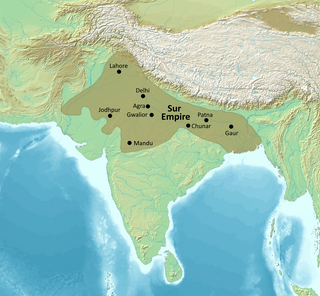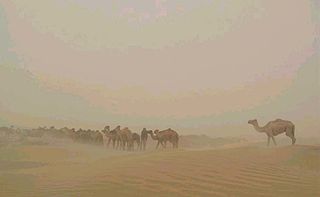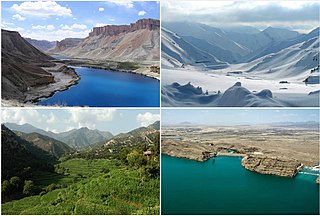
Badakhshan is a historical region comprising the Wakhan Corridor in northeast Afghanistan, eastern Tajikistan, and Taxkorgan Tajik Autonomous County in China. Badakhshan Province is one of the 34 provinces of Afghanistan. Much of historic Badakhshan lies within Tajikistan's Gorno-Badakhshan Autonomous Region in the southeastern part of the country. The music of Badakhshan is an important part of the region's cultural heritage.

Ibrahim Khan Lodi was the last Sultan of the Delhi Sultanate, who became Sultan in 1517 after the death of his father Sikandar Khan Lodi. He was the last ruler of the Lodi dynasty, reigning for nine years until 1526, when he was defeated and killed at the Battle of Panipat by Babur's invading army, giving way to the emergence of the Mughal Empire in India.

Sher Shah Suri, also known by his title Sultan Adil, was the ruler of Bihar from 1530 to 1540, and Sultan of Hindustan from 1540 until his death in 1545. He defeated the Mughal Empire, founding the Sur Empire and establishing his rule in Delhi. The influence of his innovations and reforms extended far beyond his brief reign. During his time in power, he remained undefeated in battle and was renowned as one of the most skillful Afghan generals in history. By the end of his reign, his empire covered nearly all of Northern India.

The Lodi dynasty was an Afghan royal family that ruled Sultanate of Delhi from 1451 to 1526. It was the fifth and final dynasty of the Delhi Sultanate, and was founded by Bahlol Lodi when he replaced the Sayyid dynasty.

The Sur Empire was an empire ruled by the Afghan-origin Sur dynasty in northern India for nearly 16 or 18 years, between 1538/1540 and 1556, with Sasaram serving as its capital. It was founded by Sher Shah Suri.
The Sanjrani is a sub-branch of the Baloch tribe settled in the Sindh and Balochistan provinces of Pakistan.
Yaqubzai are a Pashtun tribe of Gandapur living in Afghanistan and Pakistan.

The Battle of Jamrud was fought between the Emirate of Afghanistan under Emir Dost Mohammad Khan and the Sikh Empire under Maharaja Ranjit Singh on 30 April 1837. Afghan forces confronted the Sikh forces at Jamrud. The garrisoned army was able to hold off the Afghans till Sikh reinforcements arrived to relieve them.

Balochistan or Afghan Baluchistan is an arid, mountainous region that includes part of southern and southwestern Afghanistan. It extends into southeastern Iran and western Pakistan and is named after the Baloch of Afghanistan.

Chakhansur is a district in the Nimruz Province of Afghanistan. It has a population of about 11,165 as of 2004, which includes Baloch that form the majority followed by Tajik, and Pashtun ethnic groups.

Tourism in Afghanistan is regulated by the Ministry of Information and Culture. There are at least 350 tourism companies operating in Afghanistan. Tourism was at its peak before the 1978 Saur Revolution, which was followed by the decades of warfare. Between 2013 and 2016, Afghan embassies issued between 15,000 and 20,000 tourist visas annually. Following Taliban's return to power in August 2021, visitor numbers gradually increased from 691 in 2021 to 2,300 in 2022, reaching 7,000 in 2023.
Senator Saleem H. Mandviwalla is a Pakistani politician who served as deputy chairman of the Senate of Pakistan from March 2018 to March 2021. He was previously the president of the Board of Investment and Minister of State for Investment of Pakistan from October 2008 to May 2013. Prior to his appointment, he was the president of the Lasbela Chamber of Commerce & Industry in Lasbela, Balochistan.
Afghan Indians are Indian citizens and non-citizen residents born in, or with ancestors from, Afghanistan. As of early 2021, there are at least 15,806 Afghans temporarily residing in India under a special protection and care of the United Nations High Commissioner for Refugees (UNHCR). Apart from citizens and expatriates, there are a number of communities in India who trace their ancestry back to Pashtun forefathers of Pashtunistan.
Najabat Khan was an Afghan warrior of the 18th century, and founder of a line of chiefs of Kunjpura which he was granted by Nader Shah in 1739 and the titlehood "Nawab". Nawab Najabat Khan was killed during the Battle of Kunjpura at his fort on 17 October 1760 by the Marathas led by Ibrahim Khan Gardi during Third Battle of Panipat preparations.

Mir Muhammad Sadiq Khan Sanjrani is a Pakistani politician who had been former chairman of the Senate of Pakistan. He took his oath of office as a member and chairman of the Senate of Pakistan on 12 March 2018 and served until 15 February 2024.

Tomb of Nader Shah is a building in Mashhad designed by Hooshang Seyhoun.
Khawāja Uthmān Khān Lōhānī, popularly known as Khwaja Usman, was a Pashtun chieftain and warrior based in northeastern Bengal. As one of the Baro-Bhuyans, he was a zamindar ruling over the northern parts of Bengal including Greater Mymensingh and later in South Sylhet. He was a formidable opponent to Man Singh I and the Mughal Empire, and was the last of the Afghan chieftains and rulers in Bengal. His defeat led to the surrender of all the remaining Pashtuns as well as the incorporation of the Sylhet region into the Bengal Subah. He is described as the most romantic figure in the history of Bengal. His biography can be found in the Baharistan-i-Ghaibi, Tuzk-e-Jahangiri as well as the Akbarnama.
Sadiq is a male name. The most prominent bearer of the name is Ja'far al-Sadiq, the 8th-century Muslim scholar and scientist, considered as an Imam and founder of the Ja'fari school of jurisprudence by Twelver and Isma'ili Shi’as, and a major figure in the Hanafi and Maliki schools of Sunni jurisprudence, known at times simply as Sadiq.

Sanjrani, a significant Baloch chiefdom, the Sanjranis family who ruled Seistan with its capital at Chakansur in the early and late 19th century.
The Baloch of Afghanistan are Baloch people who live in the southwestern of Afghanistan, Balochistan Afghanistan along the border with Iran and Pakistan. The number of the Baloch in Afghanistan is estimated at 1 million people or roughly 2% of the population of Afghanistan.














